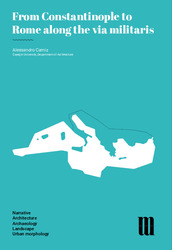From Constantinople to Rome along the via militaris
| dc.contributor.author | Camiz, Alessandro | |
| dc.contributor.editor | Ricci, M. | |
| dc.date.accessioned | 2023-09-06T12:22:36Z | |
| dc.date.available | 2023-09-06T12:22:36Z | |
| dc.date.issued | 2022-09-15 | |
| dc.identifier.issn | 978-88-6242-735-7 | en_US |
| dc.identifier.uri | http://hdl.handle.net/10679/8755 | |
| dc.description.abstract | The Mediterranean that we are describing in the Medways research is divided in two parts by an ancient line. This line dates back to the time of Diocletian who introduced the tetrarchy dividing the Roman Empire into separate administrative domains, one in the East and one in the West. Perhaps this line has shifted today from its original position, but it is still there, and the ongoing war in Ukraine seems to be a consequence of that very same line. In order to reconnect these two divided parts of the Mediterranean, and of the surrounding landscapes, we would like to build a narrative related to the road that connected the two capitals of the Eastern and Western Roman Empire. We will poetically move, as in an imitation game, from Constantinople to Rome along the so-called via militaris. This route was actually a network of roads that connected the two capitals of the empire through the Balkans. The via militaris gradually replaced by importance the older via Egnatia, which connected Constantinople to Durrës, then across the Adriatic Sea to Brindisi, and finally to Rome along the Via Appia. After the tetrarchy, when the Empire moved its gravity centre towards the Balkan area, the via militaris became the main infrastructure of an itinerant principality. It is no coincidence that Constantine the Great was born in a city along this path, Naissus (Nis). | en_US |
| dc.language.iso | eng | en_US |
| dc.publisher | LetteraVentidue Edizioni, Siracusa | en_US |
| dc.relation.ispartof | MedWays. Open Atlas | en_US |
| dc.rights | CC0 1.0 Universal | * |
| dc.rights | openAccess | |
| dc.rights.uri | http://creativecommons.org/publicdomain/zero/1.0/ | * |
| dc.title | From Constantinople to Rome along the via militaris | en_US |
| dc.type | Article | en_US |
| dc.description.version | Publisher version | en_US |
| dc.peerreviewed | yes | en_US |
| dc.publicationstatus | Published | en_US |
| dc.contributor.department | Özyeğin University | |
| dc.contributor.authorID | (ORCID 0000-0002-0318-6643 & YÖK ID 294797) Camiz, Alessandro | |
| dc.contributor.ozuauthor | Camiz, Alessandro | |
| dc.identifier.startpage | 513 | en_US |
| dc.identifier.endpage | 518 | en_US |
| dc.subject.keywords | Architecture | en_US |
| dc.subject.keywords | Landscape | en_US |
| dc.subject.keywords | Narrative | en_US |
| dc.subject.keywords | Urban Morphology | en_US |
| dc.relation.publicationcategory | Article - International Refereed Journal - Institutional Academic Staff |
Files in this item
This item appears in the following Collection(s)
Share this page




